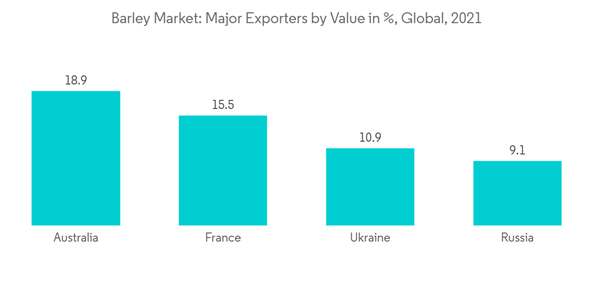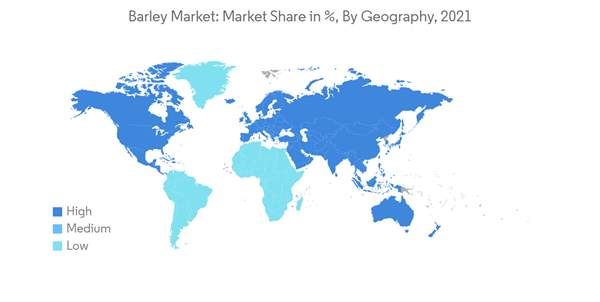Key Highlights
- Barley is the fourth most important cereal crop in the world. Europe accounts for the majority of share in global barley consumption. China, Saudi Arabia, Canada, and Turkey are the major barley-consuming countries. An increase in the demand for barley as raw material for alcoholic and non-alcoholic beverages is anticipated to drive the market's growth over the forecast period.
- The European Union is the largest producer of barley, accounting for 34% of the global production, with 51.4 million metric ton in 2021. The barley market is anticipated to witness a surge in demand due to the growing requirement for breweries. This demand is also due to the increasing demand for several types of convenience food items, clean label trends, and emerging applications in food. Barley also has potential as a pharmaceutical product due to its many benefits. It is also used to treat digestive problems such as inflammatory bowel conditions.
- In recent years, the governments in the food grain sector have largely been making progress due to an array of programs offered. For instance, to meet local demand and develop storage reserves, the Saudi government provides financial incentives to private-sector enterprises and individuals to produce strategic crops such as barley, soybeans, and yellow corn. It also credits interest-free loans and supports the growers financially. These factors have boosted the demand for barley, thus driving the market.
Barley Market Trends
Emerging Applications is Various Industries Led to Growth in Exports
In 2021, Australia was the major exporter of barley, with a volume of 8.7 million metric ton in 2021, followed by France, with 6.5 million metric ton. Rising awareness about the nutritional aspect of the consumption of whole grains is one of the major factors driving the barley market. Besides, the surging demand for including natural ingredients in snacks supports the barley market's growth. It is also preferred for the manufacture of non-alcoholic beverages. These factors are propelling the growth of the barley market across the world.Traditionally, white barley has been the preferred animal feed. It is overwhelmingly considered a carbohydrate and protein source in livestock feed. Approximately 80% of imported barley is fed to sheep, camels, and goats in the Middle East without further processing in combination with green forage. The remainder is largely used as an ingredient in dairy feed processing. Dairy farms use limited quantities of barley in their feed formulations. When it is readily available at competitive prices, barley is often used in the place of forage in many countries.
An uptick in barley malt demand for alcoholic beverages is acting as a high-impact driver for the barley market. The heightened demand for different kinds of convenience food products, emerging applications in the F&B industry, clean-label trends, and escalating demand for natural ingredients also propels this market. Thus, these factors have led to increased barley exports across the globe from countries such as France, Russia, Australia, and Ukraine. Hence, these factors are anticipated to drive the market during the forecast period.
North America is Dominating the Market
The North American barley harvest area increased by 18.7% between 2018 and 2022. Canada is the largest producer of barley in North America. Growing economies are witnessing a high adoption rate of barley in the food and beverage industry. This factor may contribute to the expansion of the barley market in the coming years.The United States is the world's seventh-largest producer of barley. About three-quarters of the barley grown in the United States is currently used for malt production. The country's producers harvested 2.2 million acres of barley in 2020 as it is widely used in soups, as an extender for vegetable proteins, and milled into flour. Barley flour contains gluten and cannot be used in gluten-free applications. It is used in the United States in baby food. Malt produced from barley is also widely used in the food industry in baked goods and flavorings.
With consumers becoming more health conscious, they are cutting back on the consumption of alcohol and spirits, restraining the demand for barley malt, which, in turn, is hindering the overall demand for barley. Other negative factors include declining soil fertility, pest and disease infestation, and drastic changes in the climate, which are affecting barley yields.
Barley Industry Overview
Additional Benefits:
- The market estimate (ME) sheet in Excel format
- 3 months of analyst support
This product will be delivered within 2 business days.










